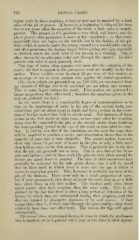Page 770 - My FlipBook
P. 770
780 DENTAL CARIES. ;
begins early in these positions,, it may or may not be marked by a dark
color of the pit or groove. If, however, a beginning is delayed for from
five to ten years after the eruption of the tooth, a dark color is usually
present. The enamel in this position is very thick and heavy, and the
pit or groove often penetrates it more or less completely ; so that caries
apparently does not begin on the outside, but in the depths, of the pit,
from which it spreads under the strong enamel to a considerable extent,
and often penetrates the dentine deeply before giving any sign, especially
in children where the dark color is not present as a warning. This is
often shown by an ashy-gray color seen through the enamel. In older
patients this color is more generally dark.
This type of caries often appears very soon after the eruption of the
tooth ; the first to appear in the permanent teeth are usually in the first
molars. These cavities occur in about 25 per cent, of first molars, or
an average of one to every patient m^io applies for dental operations.
(My charts, which are presented on pp. 782-785, are constructed from
my records of fillings, and teeth extracted are not taken into account.
This in some degree vitiates the result. First molars are extracted in
larger proportions than other teeth ; therefore the numbers given in the
text are probably too low.)
In the main, there is a considerable degree of correspondence as to
time in the beginnings of caries in the pits of the several teeth, pro-
vided these pits are about equal in depth and form ; so that in the reten-
tion of foreign matter they will be about equal. For instance, if decay
0(!curs in the first molar at eight years, or two years after its eruption,
decay may be expected in the pits of the second molar about fourteen,
the corresponding period in the age of the tooth or time after its erup-
tion. It will be seen that if the conditions are the same the same time
will be required to produce a cavity, and observation shows that in the
majority of cases this is true clinically. The second molars, however,
show only about 15 per cent, of decays in the pits, or only a little more
than half as many as the first molars. This is probably due to the fact
that the pits are generally not so deep. This is also true of the bicus-
pids and incisors ; and in these teeth (the pits are very often absent) the
decays are much fewer in number. The time of their occurrence' may
generally be reckoned by the rule given above ; but it will be noted
that in those teeth in which decay is more rare the age at which it
occurs is somewhat greater. This, however, is probably not true of the
pits of the incisors. These occur only in a small proportion of cases
but if very pronounced, they decay at about the same time as, or a little
later than, those in the first molars. The wisdom teeth often decay
much sooner after their eruption than the other teeth. This is ex-
plained by the fact that there is often a long period of irritation of the
tissues by which they are surrounded during their eruption, and that
they arc injured by absorptive jirocesses or by acid nmcus. If they
escape this—that is, if they come through the gum readily—they decay
relatively later than any other teeth. The reasons for tlys will appear
subsequently.
The second class, or proximal decays, in cases in which the predisposi-
tion is marked, are as a general rule a year or two later in their appear-


